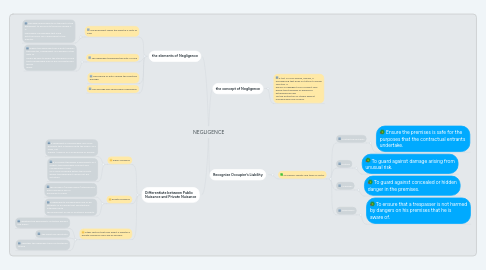
1. the elements of Negligence
1.1. The defendant owed the plaintiff a duty of care
1.1.1. The legal responsibility on the part of the defendant to avoid acts/omission where it is reasonably foreseeable that such acts/omission can cause harm to the plaintiff.
1.2. The defendant breached the duty of care
1.2.1. Where the defendant has a duty towards the plaintiff, a defendant is in breach of the duty of care if he fails to apply the standard of care that a reasonable man in his circumstances would apply.
1.3. The breach of duty caused the plaintiffs damage.
1.4. The damage was reasonably foreseeable.
2. Differentiate between Public Nuisance and Private Nuisance
2.1. Public nuisance
2.1.1. A defendant’s unreasonable use of his property that interferes with the public as a class, not merely 1 person or a small group of people.
2.1.2. It is committed when a defendant’s act affects the reasonable comfort and convenience of life of a class of people within the vicinity where the defendant carries out his activities.
2.2. private nuisance
2.2.1. the unlawful (unreasonable) interference with a person’s use or enjoyment of land.
2.2.2. A defendant’s unreasonable use of his property in a manner that substantially interferes with the enjoyment or use of another’s property.
2.3. Other factors that may affect a plaintiff’s private nuisance claim are as follows:
2.3.1. -whether the defendant’s activities benefit the public
2.3.2. -the plaintiff’s sensitivity
2.3.3. -whether the defendant was motivated by malice
3. the concept of Negligence
3.1. A tort is a civil wrong, namely, a wrongdoing that does not attract criminal sanction. A person is negligent if his conduct falls below the standards of behaviour established by law for the protection of others against unreasonable risk of harm.
4. Recognize Occupier’s Liability
4.1. Occupiers’ liability and type of visitor
4.1.1. Contractual entrants
4.1.1.1. Ensure the premises is safe for the purposes that the contractual entrants undertake.
4.1.2. Invitees
4.1.2.1. To guard against damage arising from unusual risk.
4.1.3. Licensees
4.1.3.1. To guard against concealed or hidden danger in the premises.
4.1.4. Trespassers
4.1.4.1. To ensure that a trespasser is not harmed by dangers on his premises that he is aware of.

